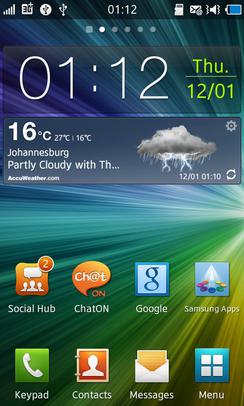
In computing, a device driver is a computer program that operates or controls a particular type of device that is attached to a computer or automaton. A driver provides a software interface to hardware devices, enabling operating systems and other computer programs to access hardware functions without needing to know precise details about the hardware being used.

Security-Enhanced Linux (SELinux) is a Linux kernel security module that provides a mechanism for supporting access control security policies, including mandatory access controls (MAC).
RTLinux is a hard realtime real-time operating system (RTOS) microkernel that runs the entire Linux operating system as a fully preemptive process. The hard real-time property makes it possible to control robots, data acquisition systems, manufacturing plants, and other time-sensitive instruments and machines from RTLinux applications. The design was patented. Despite the similar name, it is not related to the Real-Time Linux project of the Linux Foundation.
Rule-set-based access control (RSBAC) is an open source access control framework for current Linux kernels, which has been in stable production use since January 2000.
The Flux Advanced Security Kernel (FLASK) is an operating system security architecture that provides flexible support for security policies. It is a joint venture between the National Security Agency, the University of Utah, and the Secure Computing Corporation project designed to provide a framework for a more secure operating system. Development and implementation started with the Mach microkernel, and has since shifted its focus to the Linux operating system. FLASK is a core framework in security-focused operating systems such as NSA's Security-Enhanced Linux (SELinux), OpenSolaris FMAC and TrustedBSD. This means that SELinux can be thought of as an implementation of FLASK.
In computer security, mandatory access control (MAC) refers to a type of access control by which a secured environment constrains the ability of a subject or initiator to access or modify on an object or target. In the case of operating systems, the subject is a process or thread, while objects are files, directories, TCP/UDP ports, shared memory segments, or IO devices. Subjects and objects each have a set of security attributes. Whenever a subject attempts to access an object, the operating system kernel examines these security attributes, examines the authorization rules in place, and decides whether to grant access. A database management system, in its access control mechanism, can also apply mandatory access control; in this case, the objects are tables, views, procedures, etc.
Nucleus RTOS is a real-time operating system (RTOS) produced by the Embedded Software Division of Mentor Graphics, a Siemens Business, supporting 32- and 64-bit embedded system platforms. The operating system (OS) is designed for real-time embedded systems for medical, industrial, consumer, aerospace, and Internet of things (IoT) uses. Nucleus was released first in 1993. The latest version is 3.x, and includes features such as power management, process model, 64-bit support, safety certification, and support for heterogeneous computing multi-core system on a chip (SOCs) processors.
Netfilter is a framework provided by the Linux kernel that allows various networking-related operations to be implemented in the form of customized handlers. Netfilter offers various functions and operations for packet filtering, network address translation, and port translation, which provide the functionality required for directing packets through a network and prohibiting packets from reaching sensitive locations within a network.
Computer operating systems based on the Linux kernel are used in embedded systems such as consumer electronics, in-vehicle infotainment (IVI), networking equipment, machine control, industrial automation, navigation equipment, spacecraft flight software, and medical instruments in general.
The Direct Rendering Manager (DRM) is a subsystem of the Linux kernel responsible for interfacing with GPUs of modern video cards. DRM exposes an API that user-space programs can use to send commands and data to the GPU and perform operations such as configuring the mode setting of the display. DRM was first developed as the kernel-space component of the X Server Direct Rendering Infrastructure, but since then it has been used by other graphic stack alternatives such as Wayland and standalone applications and libraries such as SDL2 and Kodi.

AppArmor is a Linux kernel security module that allows the system administrator to restrict programs' capabilities with per-program profiles. Profiles can allow capabilities like network access, raw socket access, and the permission to read, write, or execute files on matching paths. AppArmor supplements the traditional Unix discretionary access control (DAC) model by providing mandatory access control (MAC). It has been partially included in the mainline Linux kernel since version 2.6.36 and its development has been supported by Canonical since 2009.
Linux Security Modules (LSM) is a framework allowing the Linux kernel to support without bias a variety of computer security models. LSM is licensed under the terms of the GNU General Public License and is a standard part of the Linux kernel since Linux 2.6. AppArmor, SELinux, Smack, and TOMOYO Linux are the currently approved security modules in the official kernel.
The concept of type enforcement (TE), in the field of information technology, is an access control mechanism for regulating access in computer systems. Implementing TE gives priority to mandatory access control (MAC) over discretionary access control (DAC). Access clearance is first given to a subject accessing objects based on rules defined in an attached security context. A security context in a domain is defined by a domain security policy. In the Linux security module (LSM) in SELinux, the security context is an extended attribute. Type enforcement implementation is a prerequisite for MAC, and a first step before multilevel security (MLS) or its replacement multi categories security (MCS). It is a complement of role-based access control (RBAC).

Moblin, short for 'mobile Linux', is a discontinued open source operating system and application stack for Mobile Internet Devices (MIDs), netbooks, nettops and embedded devices.

The kernel is a computer program at the core of a computer's operating system and generally has complete control over everything in the system. The kernel is also responsible for preventing and mitigating conflicts between different processes. It is the portion of the operating system code that is always resident in memory and facilitates interactions between hardware and software components. A full kernel controls all hardware resources via device drivers, arbitrates conflicts between processes concerning such resources, and optimizes the utilization of common resources e.g. CPU & cache usage, file systems, and network sockets. On most systems, the kernel is one of the first programs loaded on startup. It handles the rest of startup as well as memory, peripherals, and input/output (I/O) requests from software, translating them into data-processing instructions for the central processing unit.

The Linux kernel is a free and open-source, UNIX-like kernel that is used in many computer systems worldwide. The kernel was created by Linus Torvalds in 1991 and soon after was adopted as the kernel for the GNU operating system (OS) which was created to be a free replacement for Unix.

Tomoyo Linux is a Linux kernel security module which implements mandatory access control (MAC).

Bada is a discontinued mobile operating system developed by Samsung Electronics for devices such as mid- to high-end smartphones and tablet computers. The name is derived from "바다 (bada)", meaning "ocean" or "sea" in Korean. All phones running Bada were branded with the name Wave, unlike Samsung's Android devices which are branded as Galaxy.

MeeGo is a discontinued Linux distribution hosted by the Linux Foundation, using source code from the operating systems Moblin and Maemo. MeeGo was primarily targeted at mobile devices and information appliances in the consumer electronics market. It was designed to act as an operating system for hardware platforms such as netbooks, entry-level desktops, nettops, tablet computers, mobile computing and communications devices, in-vehicle infotainment devices, SmartTV / ConnectedTV, IPTV-boxes, smart phones, and other embedded systems.
In computer security, the Linux Intrusion Detection System (LIDS) was a patch to the Linux kernel and associated administrative tools that enhanced the kernel's security by implementing mandatory access control (MAC). When LIDS was in effect all system network administration operations, chosen file access, any capability use, raw device, memory, and I/O access could be made impossible, even for root. One could define which programs can access specific files. It used and extended the system capabilities bounding set to control the whole system and added some network and filesystem security features to the kernel to enhance the security. One could finely tune the security protections online, hide sensitive processes, receive security alerts through the network, and more. LIDS supported Linux kernel 2.6, 2.4. LIDS was released under the terms of the GNU General Public License (GPL).









